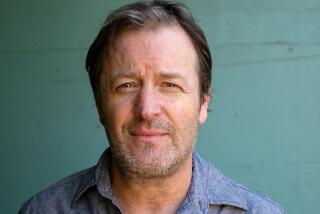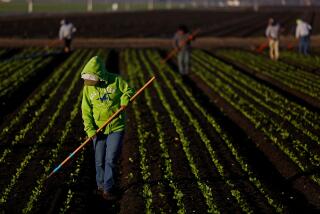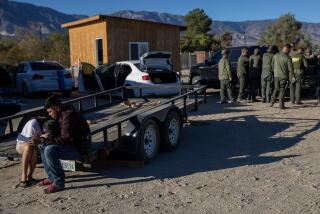Eire Unfolds Astride a Spirited Steed
- Share via
SLIGO, Ireland — It’s hard to imagine that there remains in this world a man who will greet you as a friend even though you are a stranger, house and feed you, and let you choose from among his hundred sleek, spirited horses to ride off on your own across a gorgeous landscape for a week or two.
To Tilman Anhold, this is simply perpetuating the generosity extended to him three decades ago. At 29, he came on holiday to County Sligo from Celle near Hanover in his German homeland, looked around at this wind-torn outreach of northwestern Ireland and, being an experienced rider, decided he could best see this land by horse.
The Irish tourist board put Anhold in touch with Don Wall, who operated a horse-drawn caravan business in County Leitrim. Wall agreed to let Anhold have a horse for the trip and called ahead to a friend in Dromahaire to ask whether horse and man could be accommodated for the night. His host in Dromahaire gave Anhold directions to the farm of Agnes McDonagh in Ballintogher, where the German visitor could depend on lodging the next night.
Anhold spoke fairly good English; Agnes’ daughter, Colette, knew a few words of German. Together, Colette and Tilman hatched the notion of turning Tilman’s adventure into a joint venture.
The two were married a year later. By then they had acquired 35 horses and a house on 50 acres, and started Horse Holiday Farm.
Thirsting for adventure and longing to ride on our own without guides across the open Irish countryside, my husband, Pat, and I traveled to County Sligo in May two years ago. Although we had been keen equestrians in our youth, the opportunities to ride had dwindled. But we were confident our skills would prevail.
After a four-hour trip from Dublin by train and car, we turned in at the gate and drove past fields and paddocks of lustrous horses, grazing and lazing in the afternoon sun, their long manes and tails flicking in the breeze. At the edge of a cliff high above Donegal Bay, we stepped out at the main house and were greeted by Colette, whose warm manner melted away the miles.
The beauty of the scene--a panorama of the Slieve League peninsula, with four strands of beach and as many separate weather systems--left us in awe. Colette pointed out the solitary and eerie Classiebawn Castle at Mullaghmore, on a promontory to the distant far right. Then, with a sweeping gesture to the left, she identified each strand of beach: Mullaghmore, then Cliffony, Streedagh and Lissadel, and told us that at low tide we could ride on all four, from one to the other.
To the left was Sligo Bay, shimmering in the late-day sun, and directly behind us a few miles away was the smooth, hulking form of Benbulbin, below whose bare, sloping head, in Drumcliffe churchyard, lies the grave of William Butler Yeats, marked by a stone etched with his words: “Cast a cold eye / On life, on death / Horseman, pass by!”
We turned toward the house, whose gray stucco walls and heavy doors gave it the look of something meant to withstand the elements. By contrast, the interior, with its polished hardwood floors and contemporary furnishings, is warm and inviting. In the dining room, which has a picture window overlooking the bay, a long wooden table was set for tea.
Upstairs, our spacious room had a simple Bavarian motif, with big puffed comforters on the beds and a view toward Mullaghmore.
Colette suggested we have some tea and cake before heading for the stables to meet Tilman and be matched up with our mounts.
Tilman Anhold is a fair-haired, burly man, now 60, brimming with energy and mirth. An Irish lilt is woven into his German-accented English, and judging from his banter with the youthful staff, he runs the farm with firm but friendly Teutonic efficiency.
To determine which horse to offer, he asked only two questions: How long have you been riding? What manner of horse do you want? Then he consulted his list of 120 and made a match: for me, a sweet-faced dark bay named Lomond, and for Pat, a heftier, lighter bay named Guinness.
All of Anhold’s horses are Irish hunters--a cross between a thoroughbred stallion and a warmblood Irish draught mare--or the bigger, heftier Irish draught horses with huge plumed lower legs and feet. They are beautiful, powerful and willing, as well as gentle and sure-footed. Most of Anhold’s horses are bred and raised right there on the farm.
That first evening, during a sumptuous dinner of shellfish and chateaubriand with the six other guests, most of whom had also just arrived, the mood of excitement and conviviality gave way to gallows humor as a rainstorm began.
Back in our room, we stayed up half the night distilling the contents of our suitcases into two small sets of saddlebags (one sack to be left empty for halter and grooming gear) and reading a 15-page booklet of farm rules and cautionary tales as huge gusts of wind and rain pounded against the walls.
I thought of naturalist John Muir, who once tied himself to a tree during a fierce storm to experience what the tree was going through, and I was having some serious second thoughts about riding off into what might be six straight days of something similar.
By morning the rain had diminished to a drizzle. After breakfast of juice, muesli, porridge, eggs, sausage, bacon, grilled tomatoes and toast, we saddled up for a ride on Cliffony Strand to test Anhold’s matchmaking skills.
Itching to run, the horses began to prance when we reached the sand. Anhold told us to give them free rein on the beach, so I gripped Lomond’s mane just as he surged into a fast, elongated trot and then into an undulating gallop. The horses are so big and powerful that every sensation seemed exaggerated. The sound of hooves pounding the sand drowned out the crashing of the surf and was in turn muted by the rush of wind and the throb of blood inside my head.
After half an hour of putting the horses through their paces, we turned back toward the farm. The sun had broken through the overcast, and we were relishing the prospect of hitting the Donegal Trail for a week of unfettered freedom.
Anhold gave us a map of the ride that he had hand-colored with Xs marking the location of each night’s lodging. At each farm there would be a bed and bath for us, a breakfast so big that we would pack part of it each day for our lunch, and a field and feed for the horses. Dinner with our hosts was optional.
Anhold told us we would find yellow arrows at every junction to indicate the trail. He circled the location of a couple of pubs we would pass, and then, placing another X on the map just before the village of Bridgetown, he said, “Don’t let the horses drink the water here.” But he didn’t explain why, and we assumed--wrongly--that the ground water was tainted.
Then we were off.
For the next four days we galloped for miles across white sand beaches and walked and trotted down one-lane country roads, across fields and through forests, and along narrow footpaths lined with a riot of rhododendron, Scotch broom and hazel in full bloom. We went for hours without seeing other people. All along the way were ghostly relics of the past--crumbling stone fences and long-abandoned stone cottages. Windows that once glowed with candlelight now stared back blankly through fluttering shreds of old gray lace. Newborn lambs bleated and ran to their mothers, startled by the clatter of hooves.
The weather spanned the seasons, sometimes all in one hour. One moment we were galloping along a beach in bright sunshine as big clouds billowed on the horizon; the next moment we faced a blackened sky. Within minutes we might be riding into a hailstorm, stones the size of ripened peas bouncing off our helmets. We quickly learned to get in and out of our slickers without dismounting, which was fine since we could be sun-dried 15 minutes after a drenching rain.
The yellow arrows proved more challenging than the weather. From the beginning we learned that they were easy to miss or misread. The second one we saw was bent around a utility pole. We decided it meant “go straight,” but it actually meant we should cut to the right onto a faint trail through a field. We ended up on a busy road just outside the fair-sized manufacturing town of Ballyshannon at the 5:30 p.m. rush hour.
Checking the map and realizing our mistake, we turned and rode several kilometers back to a small quarter-horse ranch, whose owner, coincidentally, was Colette’s first cousin. After offering us tea, which we reluctantly declined, he directed us back to the trail.
At the end of our second day we were rescued by our intended host, John Boyle, who was returning from the nearby town of Donegal in time to greet us at his farm. Hunkered in our hooded slickers, we had missed the turn and were unknowingly following the next day’s arrows.
“Will you be looking for someone?” he asked with a broad grin as he leaned out the car window. He led us to the farm, where his wife, Philomena, gave us hot tea and arranged our wet clothes around a big iron stove, the centerpiece of the living room.
There were many more missed or missing arrows in the days to come. In the more remote regions, when we ran out of arrows and were just as confused by the map, we tried to go by our instincts. These times invariably led to a wonderful encounter with a shepherd, a farmer, a fisherman or a woman gardening or hanging laundry, who would sometimes greet us with “Aye, you must be from Tilman’s,” before setting us in the right direction.
These misadventures often led to nine-hour days and late-evening arrivals. On the first day’s stopover, Rose McCaffrey, one of the mistresses of Cavangarden, a beautiful country estate set in 1,000 rolling green acres, returned from her evening walk and found me lying at a rear gate looking up at my horse. Dismounting to open the latch, I had caught my foot on a saddlebag, slid to the ground and was too exhausted to move. Laughing, Rose helped with the gate, and we rode on in through neatly groomed grounds to a large stone manor house on a circular driveway.
Each night was a different barn but the same routine: Brush down the horses, give them grain and water, and turn them out into a field for the night. In the mornings we often found them lolling in the tall grass, sometimes allowing us to approach and even put their halters on before they lurched up onto their feet.
We were too late for the evening meal at Cavangarden, so we washed up and called a taxi to drive us back into Ballyshannon, the nearest town. By the time we arrived, it was almost 10 p.m. and the three main restaurants were closed. We finally coaxed a pizza chef to make one last pie for us, and we carted it off to a local pub, where we ate ravenously and drank warm Guinness stout.
As we neared Bridgetown the next day, mindful of Anhold’s admonition not to let the horses drink the water, we kept the animals from approaching streams along the way. As we neared the town and were riding along a lane behind some houses, we saw a large barrel brimming with what must have been rainwater.
The horses headed straight for it, half-submerging their heads. Just then, an elderly woman rushed around the side of the house with both arms raised, shouting, “Don’t let the horses drink the water!” and we realized this was her drinking water, the water that Anhold had warned us about. Apologies would not suffice. We rode on, feeling stupid and remorseful.
On the third day, we turned east away from the beaches and were heading through peat bogs and into more mountainous terrain, alternately walking and trotting for hours through a seedling pine forest until we suddenly came upon the stunning Lough Derg. Rising from the water, mirage-like, was the large, mysterious form of the basilica known as St. Patrick’s Purgatory, a destination for Christian pilgrims since medieval times.
The skies had just cleared, and I would happily have ridden around and around the shores until nightfall, but we were driven off by swarms of tiny gnats with big appetites.
It was less than an hour’s ride from here to the town of Pettigo, where we stayed the night at Carne, the farmhouse of Mary Greene, a reserved and soft-spoken woman who was gracious and attentive to our needs, including proffering a packet of frozen peas for my slightly swollen sprained thumb, as we all sat down for tea.
The next day, after riding again for hours and becoming increasingly anxious that we might have missed a turn, a new feature of this treasure hunt occurred to us: We could quit. Just that fast, we turned the horses and headed back to Pettigo. After reserving another night at Carne, we spent the afternoon and evening riding in the hills above the town. As the warm sunshine faded softly and a light breeze quickened, we luxuriated in the knowledge that we couldn’t get lost.
That evening we called Anhold to tell him of our change of plans, and he arranged to send a truck in the morning to trailer us with the horses back to Horse Holiday Farm.
There we spent the rest of the week riding by the sea on the spectacular trails and beaches around Horse Holiday Farm and relaxing again in the embrace of Colette’s hospitality.
It’s not unusual for riders to cry when they part with their horses on the last day at the farm, and I was no exception. Those who find the pain unbearable can buy their horse from Anhold and take it home. Bestowing big strokes and hugs and murmured endearments on Lomond, I instead vowed to return another year to ride the Sligo Trail.
*
Guidebook: A Horse Trip in the Irish Wilds
Getting there: The nearest major airports are Dublin and Shannon. From LAX, service to both cities is offered on Air Canada, Continental, Delta, Lufthansa, KLM, British, United and American through Chicago or New York and connecting to Aer Lingus. Restricted round-trip fares begin at $778 and $758, respectively.
At both airports, rental cars are available for $50 with a drop-off in Sligo, which is 12 miles from Horse Holiday Farm.
Riding on your own: Horse Holiday Farm, 011-3537-166-152, fax 011-3537-166-400, www.horseholidayfarm.net. The Sligo Trail and one of the Donegal Trail rides, both one week, cost $925 low season (Easter-July 5 and Aug. 25 to mid-October) and $995 high season (July 6-
Aug. 24). The two-week Donegal Trail ride is $1,850 low season and $1,990 high season.
Riding by the Sea, where guests ride each day and return to the farm in the evenings for dinner and the night, is $1,150 low season and $1,280 high season for one week.
For more information: Irish Tourist Board, 345 Park Ave., 17th Floor, New York, NY 10154; (800) 223-6470 or (212) 418-0800, fax (212) 371-9052, www.tourismireland.com. The board offers Equestrian Holidays Ireland, a free 48-page booklet that contains information on more than 30 centers that offer riding, ranging from day trips to more extensive programs.
*
Anne Dowie is a freelance writer and photographer living in San Francisco.
More to Read
Sign up for The Wild
We’ll help you find the best places to hike, bike and run, as well as the perfect silent spots for meditation and yoga.
You may occasionally receive promotional content from the Los Angeles Times.






